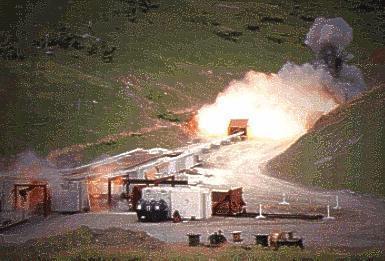SHARP (original) (raw)

Home - Search - Browse - Alphabetic Index: 0- 1- 2- 3- 4- 5- 6- 7- 8- 9
A- B- C- D- E- F- G- H- I- J- K- L- M- N- O- P- Q- R- S- T- U- V- W- X- Y- Z
SHARP

Livermore Gas Gun
Credit: Lawrence Livermore Laboratory
American gun-launched test vehicle. The SHARP (Super High Altitude Research Project) light gas gun was developed by Lawrence Livermore Laboratory in California. The L-shaped gun consisted of the 82 m long, 36 cm caliber pump tube and the 47 m long, 10 cm caliber gun barrel. SHARP began operation in December 1992 and demonstrated velocities of 3 km/sec with 5 kg projectiles. However the $ 1 billion funding to elevate the tube and begin space launch tests of smaller projectiles at speeds of up to 7 km/sec was not forthcoming. By 1996 the gun was relegated to occasional test of sub-scale Mach 9 scramjet models.
AKA: Livermore Light Gas Gun;Super High Altitude Research Project. Status: Cancelled 1995. Payload: 1.00 kg (2.20 lb). Apogee: 160 km (90 mi).
The SHARP (Super High Altitude Research Project) light gas gun was developed by John Hunter at Lawrence Livermore Laboratory in California. In 1985 Hunter was reviewing data for a 'star wars' anti-ballistic missile electromagnetic rail gun. He realized that a light gas gun would be much more efficient in launching projectiles to a good percentage of orbital speed.
No gun projectile can exceed the velocity of the propellant gases in the barrel. The light gas gun takes advantage of the fact that a lower molecular weight gas, such as hydrogen, has a higher velocity at a given temperature than the heavier molecules of conventional gun propellants. In order to heat the hydrogen up, a two-stage design was developed. A gas pump tube was set at a right angle to the gun barrel itself. Inside the pump tube was a piston. An explosive mixture of methane gas was ignited, pushing the piston down the tube, compressing and heating the hydrogen gas on the other side of the piston. When the pressure reached 4,000 atmospheres, a partition burst, releasing the gas into the gun tube, pushing the projectile down its length. As in the Oberth design, the barrel itself was depressurized and covered with a plastic lid to reduce drag against the projectile as it travelled down the barrel. Using this approach, Hunter felt that muzzle velocities of up to 7 km/sec could be obtained (compared to Bull's 2 km/sec). At this speed, a simple single-stage rocket stage would be sufficient to place a payload into orbit. The payload itself would amount to 66% of the launch mass.
Hunter's research discovered that a small NASA gas gun had achieved a projectile speed of 11 km/sec in 1966. The first hardware built was a single-stage hydrogen gas gun demonstrating a muzzle velocity of 2.5 km/sec. This verified Hunter's gun computer model and lead to funding to build a 3 m long two-stage gas gun with a velocity of 8 km/sec. This demonstrated the principle of SHARP and resulted in funding for construction of the full-scale gun.
SHARP was built at Lawrence Livermore's Site 300 explosives test site in the hills to the east of the laboratory. The L-shaped gun consisted of the 82 m long, 36 cm caliber pump tube and the 47 m long, 10 cm caliber gun barrel. Recoil forces were absorbed by three rail-mounted sleds-two of 100-metric tons and one of 10-metric tons. SHARP began operation in December 1992 and demonstrated velocities of 3 km/sec with 5 kg projectiles. However the $ 1 billion funding to elevate the tube and begin space launch tests of smaller projectiles at speeds of up to 7 km/sec was not forthcoming. By 1996 the gun was relegated to occasional test of sub-scale Mach 9 scramjet models.
LEO Payload: 1.00 kg (2.20 lb) to a 160 km orbit at 43.00 degrees. Payload: 5.00 kg (11.00 lb) to a 3 km/sec suborbital trajectory.
Family: Gun-launched, test vehicle. Country: USA. Agency: Livermore. Bibliography: 462, 463.
1985 - . Launch Vehicle: SHARP.
- SHARP (Super High Altitude Research Project) light gas gun design work begun - . Nation: USA.
The SHARP (Super High Altitude Research Project) light gas gun was developed by John Hunter at Lawrence Livermore Laboratory in California. In 1985 Hunter was reviewing data for a 'star wars' anti-ballistic missile electromagnetic rail gun. He realised that a light gas gun would be much more efficient in launching projectiles to a good percentage of orbital speed.
1992 December - . Launch Vehicle: SHARP.
- The SHARP (Super High Altitude Research Project) light gas gun began operation - . Nation: USA.
SHARP began operation and demonstrated velocities of 3 km/sec with 5 kg projectiles. However the $ 1 billion funding to elevate the tube and begin space launch tests of smaller projectiles at speeds of up to 7 km/sec was not forthcoming. By 1996 the gun was relegated to occasional test of sub-scale Mach 9 scramjet models.
Home - Search - Browse - Alphabetic Index: 0- 1- 2- 3- 4- 5- 6- 7- 8- 9
A- B- C- D- E- F- G- H- I- J- K- L- M- N- O- P- Q- R- S- T- U- V- W- X- Y- Z
© 1997-2019 Mark Wade - Contact
© / Conditions for Use